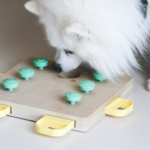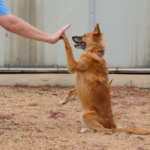Introduction
Dog digging is a common behavior in dogs that, while instinctive, can sometimes pose challenges for pet owners. This guide aims to delve into the reasons behind dog digging, its potential issues, and practical solutions to manage and redirect this behavior.
The Roots of Dog Digging
Digging is an instinct deeply ingrained in a dog’s DNA, influenced by a combination of breed characteristics, age, and environmental factors. By exploring the natural instincts that drive this behavior, dog owners can gain valuable insights into their pet’s actions.
Different dog breeds exhibit varying levels of digging behavior, rooted in their historical roles. Terriers, for instance, were originally bred for hunting and digging out prey. Understanding breed tendencies can provide clues to the intensity of a dog’s digging instinct. While some breeds may have a more pronounced drive to dig, others might display it less prominently.
Age plays a significant role in digging behavior. Puppies, in particular, are prone to digging as a form of exploration, play, and teething. As they grow, digging may become a more intentional behavior linked to their instincts. Older dogs may dig to create a comfortable spot for rest or to hide possessions, reflecting behaviors inherited from their wild ancestors.
Environmental factors contribute substantially to a dog’s digging tendencies. Dogs often dig to create a cool spot in hot weather, seeking relief from the heat. They may also dig to find cooler soil or create a sheltered spot for nesting. Recognizing these triggers helps pet owners address the root cause rather than viewing digging as a problematic behavior.
Delving into the innate behaviors associated with digging unveils its natural purpose. Dogs dig to create a den-like space, mimicking their wild ancestors who dug to build nests for protection. Understanding these instincts allows dog owners to provide alternative outlets for these behaviors, such as providing a designated digging area or engaging in interactive play.
Identifying Problematic Dog Digging
While digging is a natural behavior for dogs, certain signs indicate when it has escalated into a problematic issue. Recognizing these signs is crucial for dog owners to address concerns effectively and maintain a harmonious living environment.
Excessive digging is one of the primary indicators that the behavior has become problematic. If a dog is consistently digging in various areas of the yard or home, it may be a sign of an underlying issue that needs attention. This behavior could result from boredom, anxiety, or a lack of mental and physical stimulation.
Destruction of property is another red flag. If a dog is not only digging but also causing damage to plants, flowers, or other items in the yard, it can be a cause for concern. This behavior not only poses a threat to the dog’s well-being but can also lead to frustration for the owner.
Potential hazards associated with digging should be carefully assessed. Dogs may unearth toxic plants, electrical wires, or other dangerous items during their digging escapades. This creates a risk of ingestion or injury, requiring immediate intervention to ensure the dog’s safety.
Common concerns such as ruined gardens or escape attempts are frequent outcomes of problematic digging. Gardens meticulously cared for can be turned into unsightly craters, causing frustration for dog owners who take pride in their outdoor spaces. Additionally, dogs may attempt to dig under fences or walls, increasing the risk of escape.
Addressing problematic digging involves a multi-faceted approach. Providing ample physical and mental stimulation, offering designated digging areas, and reinforcing positive behaviors through training are effective strategies. Identifying the root cause of the behavior allows owners to tailor interventions to their dog’s specific needs.
Practical Solutions To Excessive Dog Digging
Dealing with a dog’s digging behavior can be challenging, but understanding effective solutions is the key to maintaining a harmonious living space for both pets and owners. Here are practical strategies to manage and redirect digging tendencies in your furry friend.
- Environmental Enrichment: Dogs often dig out of boredom or the need for mental stimulation. Enrich their environment with engaging toys, puzzle feeders, and interactive games. This helps channel their energy into constructive activities, reducing the urge to dig for entertainment.
- Designated Digging Areas: Provide an outlet for your dog’s natural digging instincts by creating a designated digging zone in your yard. Fill it with loose soil or sand, making it an appealing alternative to other areas. Encourage your dog to use this space by burying toys or treats, turning it into a fun and rewarding activity.
- Positive Reinforcement: Reinforce positive behavior by rewarding your dog when they exhibit good conduct. Use treats, praise, or toys to encourage alternative activities like playing with toys or lying in a designated area. Positive reinforcement helps shift their focus away from digging as a default behavior.
- Supervision and Correction: Keep a watchful eye on your dog when they are in the yard. If you catch them in the act of digging in an undesirable spot, gently redirect their attention to a designated area. Avoid scolding, as this may create anxiety. Instead, provide positive reinforcement when they use the designated space.
- Tire Them Out with Exercise: A tired dog is less likely to engage in destructive behaviors. Ensure your dog receives sufficient physical exercise through regular walks, play sessions, or other activities. A tired dog is more likely to rest peacefully than engage in digging antics.
Implementing a combination of these practical solutions can significantly reduce and redirect your dog’s digging behavior. Consistency and positive reinforcement are crucial for success. Remember, understanding your dog’s needs and providing appropriate outlets for their natural instincts is key to a happy and well-behaved furry companion.
Conclusion
In conclusion, the goal is not to suppress a dog’s natural behaviors but to channel them in a way that aligns with a harmonious coexistence. Through informed insights and compassionate training methods, dog owners can forge a stronger bond with their furry friends, creating a backyard space that is enjoyable for both canine companions and their human families.









